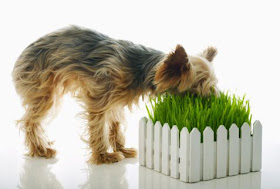
There is much debate about why dogs eat grass. Some dogs seem to act like mini lawnmowers, eating grass at every opportunity. Others dogs eat grass only occasionally, and throwing it up.
There actually appears to be two types of grass eating behavior in dogs. Some dogs take a few nibbles, while others eat quickly, barely chewing the grass. Unchewed grass often translates to near instant vomiting. Dogs that are careful grazers, on the other hand, may not get sick from grass.
The latter case suggests that some dogs eat grass because they enjoy it. Most dogs do not need it to supplement their diets, but because dog diets are primarily made up of herbivores, that grassy taste may be reminiscent of the cattle or lamb product they had for dinner. Some dogs also enjoy green vegetables like broccoli.
Although not all dogs like wheatgrass many will nibble on the stalks or enjoy the clippings in their food bowl. Growing weatgrass is easy, try it to see if your dog likes it. If your dog does like it, you can keep the grass growing or start larger trays. Maybe even juice some of it for yourself!
What you need:1/4 cup organic hard red wheat berries
fine mesh strainer
glass jar with lid
two plastic trays with holes for drainage, about 6 inch square, and something to put them on, like a saucer or tray
1/2 cup potting mix
paper towels
How to make it:1. Rinse the wheat berries in the strainer for about one minute, shaking to rinse will.
2. Pour the wheat berries into the jar and cover with about 1 cup of water.
3. Let the wheat berries soak for 8 to 12 hours. During cold weather, they may need to soak a bit longer. When you see tiny white sprouts on the ends of the berries, they are ready to plant. These may look like nothing more than white dots that were not there before.
4. Fill one plastic tray with the potting mix and put it on a saucer or drainage tray.
5. Drain the wheat berries into the strainer again, and gently rinse. Spread them evenly over the potting mix.
6. Put three layers of paper towels over the seeds and water the paper towels. Put the second tray on top, upside down, acting as a lid.
7. Water the paper towels as needed to keep them moist. After 24 hours, check to see if your wheat berries have sprouted and keep watering.
8. When the grass is about one inch tall (this should take about three days, depending on temperature), remove the paper towels and the lid and put the wheatgrass in a sunny window. Water daily.
9. When the wheat grass is 4 to 6 inches tall and bright green, set the tray where your dog can take a nibble. If your dog is not interested, clip off bits of grass with a scissors into his dog food.
Small dogs can eat about a tablespoon of grass clippings. Large dogs might enjoy up to about 1/2 cup with their regular kibble.
















